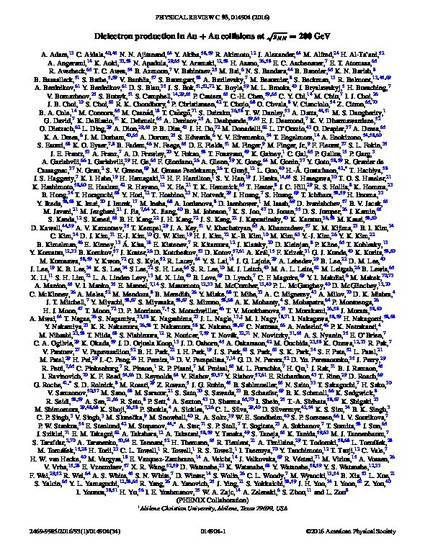
Article
Dielectron production in Au plus Au collisions at root s(NN)=200 GeV
Physical Review C
Document Type
Article
Publication Version
Published Version
Publication Date
1-11-2016
DOI
10.1103/PhysRevC.93.014904
Abstract
We present measurements of e(+)e-production at midrapidity in Au + Au collisions at root s(NN) = 200 GeV. The invariant yield is studied within the PHENIX detector acceptance over a wide range of mass (m(ee) < 5 GeV/c(2)) and pair transverse momentum (p(T) < 5 GeV/c) for minimum bias and for five centrality classes. The e(+)e(-) yield is compared to the expectations from known sources. In the low-mass region (m(ee) = 0.30-0.76 GeV/c(2)) there is an enhancement that increases with centrality and is distributed over the entire pair p(T) range measured. It is significantly smaller than previously reported by the PHENIX experiment and amounts to 2.3 +/- 0.4(stat) +/- 0.4(syst) +/- 0.2(model) or to 1.7 +/- 0.3(stat) +/- 0.3(syst) +/- 0.2(model) for minimum bias collisions when the open heavy-flavor contribution is calculated with PYTHIA or MC@NLO, respectively. The inclusive mass and p(T) distributions, as well as the centrality dependence, are well reproduced by model calculations where the enhancement mainly originates from the melting of the rho meson resonance as the system approaches chiral symmetry restoration. In the intermediate-mass region (m(ee) = 1.2-2.8 GeV/c(2)), the data hint at a significant contribution in addition to the yield from the semileptonic decays of heavy-flavor mesons.
Copyright Owner
American Physical Society
Copyright Date
2016
Language
en
File Format
application/pdf
Citation Information
Andrew Adare, Nicole J. Apadula, Sarah C. Campbell, Lei Ding, et al.. "Dielectron production in Au plus Au collisions at root s(NN)=200 GeV" Physical Review C Vol. 93 Iss. 1 (2016) p. 014904 Available at: http://works.bepress.com/craig-ogilvie/28/

This is an article from Physical Review C 93 (2016): 014904, doi:10.1103/PhysRevC.93.014904. Posted with permission.